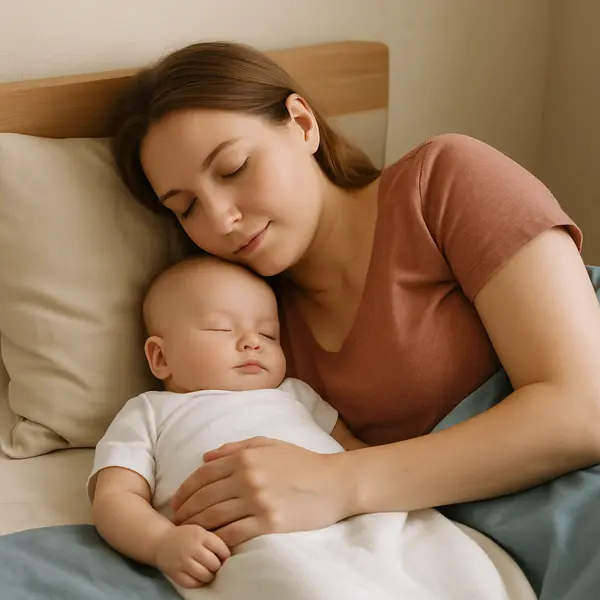- Is Co-Sleeping Safe for My Baby?
- Understanding What Co-Sleeping Really Means
- When Not to Co-Sleep
- Cultural and Social Contexts of Co-Sleeping
- Final Thoughts: Is Co-Sleeping Safe for My Baby?
Is Co-Sleeping Safe for My Baby?
Many parents find themselves wondering, “Is co-sleeping safe for my baby?” This question isn’t just common—it’s critical. The practice of co-sleeping, where babies sleep close to or in the same bed as caregivers, has sparked debate among parents, pediatricians, and researchers alike. As the practice gains popularity in some parts of the world and faces caution in others, it’s important to understand the evidence behind both the risks and benefits.
Understanding What Co-Sleeping Really Means
Co-sleeping can take different forms:
- Bed-sharing: the baby and caregiver share the same bed.
- Room-sharing: the baby sleeps on a separate surface in the same room.
- Couch/sofa sleeping: an extremely risky form of co-sleeping that should always be avoided.
Experts like McKenna emphasize that not all co-sleeping is equal—bed-sharing is not the same as room-sharing, and the safety of each depends on the surrounding circumstances.
What the Research Says About Co-Sleeping Safety
So, back to our main question: is co-sleeping safe for my baby? The answer is—it depends.
According to research from Blair (2008) and Fleming & Blair (2015), co-sleeping can be safe when practiced correctly and under specific conditions. Epidemiological studies show an increased risk of Sudden Infant Death Syndrome (SIDS) associated with unsafe bed-sharing, especially when the parent has consumed alcohol, smokes, or is extremely tired.
On the other hand, studies such as Keegan (2017) found that structured, safe co-sleeping environments like infant safer sleep boxes (ISSBs) actually increased breastfeeding duration, improved maternal proximity, and reduced risks like head covering.
Benefits of Co-Sleeping
When done safely, co-sleeping can offer multiple benefits:
- Enhanced breastfeeding frequency and duration (McKenna & McDade).
- Improved sleep regulation and stronger emotional bonding between mother and child.
- Less night-time crying and easier soothing (Blair, 2008).
- Better thermoregulation and oxygenation in infants.
When Not to Co-Sleep
Situations Where Co-Sleeping Is Not Recommended
There are circumstances in which the answer to “is co-sleeping safe for my baby” is clearly no. You should avoid co-sleeping if:
- You or your partner smokes.
- You’ve used alcohol, drugs, or sedatives.
- Your baby was born prematurely or has a low birth weight.
- You’re sleeping on a sofa or armchair (About Co-Sleeping doc).
These factors significantly increase the risk of SIDS or accidental suffocation.
Safe Co-Sleeping Practices
To make co-sleeping safer, consider the following practices:
- Always place your baby on their back on a firm, flat mattress.
- Keep pillows, blankets, and toys away from the baby’s sleep space.
- Position the baby on one side of the bed, away from the edge.
- Use a safe infant sleeping bag instead of loose bedding.
- Never co-sleep on a couch or soft surface.
These practices align with guidelines from the National Institutes of Health (NIH) and the Lullaby Trust, both of which stress the importance of safe sleep environments.
Cultural and Social Contexts of Co-Sleeping
Research reveals that the perception of whether co-sleeping is safe for my baby varies widely across cultures. In countries like Japan and Hong Kong, where co-sleeping is common and smoking rates are low, SIDS rates are among the lowest in the world.
In contrast, in places like the United States, public health campaigns often stigmatize all forms of bed-sharing, without distinguishing between safe and unsafe versions (Harrison, 2018). This oversimplification can limit access to essential safety information for families who choose to co-sleep.
Risk Elimination vs. Risk Management
Some public health strategies aim to eliminate co-sleeping altogether. But as Harrison (2018) and McKenna (2005) argue, this overlooks the complex realities of modern parenting and may lead to even riskier behaviors, such as falling asleep with a baby on a couch. A better strategy is risk management—educating parents on how to co-sleep safely within their unique environments.
Final Thoughts: Is Co-Sleeping Safe for My Baby?
So, is co-sleeping safe for my baby? The answer is not black-and-white. When done safely—avoiding high-risk conditions and following expert guidance—co-sleeping can be both nurturing and protective. However, it requires mindfulness, preparation, and awareness of individual circumstances.
Remember: safe sleep doesn’t have to mean separate sleep. Parents can make informed, safe choices that work for their family while ensuring their baby’s well-being.
The following post may interest you
What to Do If My Baby Won’t Sleep at Night? Effective Strategies
Sources
Why babies should never sleep alone: A review of the co-sleeping controversy in relation to SIDS, bedsharing and breast feeding
https://www.sciencedirect.com/science/article/pii/S1526054205000230
What’s Best for Baby? Co-Sleeping and the Politics of Inequality
https://www.jstor.org/stable/10.5250/fronjwomestud.39.3.0063
Making informed choices on co-sleeping with your baby
https://www.bmj.com/content/350/bmj.h563.full.pdf+html
Putting co-sleeping into perspective
https://www.scielo.br/j/jped/a/6DyF4ssYYjfkKqkWQzSWsQG/?lang=en
Safe co-sleeping for all babies: Do infant safer sleep boxes provide a safe and bene cial sleep environment for infants?
http://etheses.dur.ac.uk/12043/1/Alice-AmberKeeganMScThesis.pdf
Cosleeping and Biological Imperatives: Why Human Babies Do Not and Should Not Sleep Alone
https://bestdoulas.com/wp-content/uploads/2020/07/why-cosleep.pdf

